Nimue Brown's Blog, page 145
April 1, 2021
Modern Druidry and Priesthood
One of the most striking ideas in 20th century Paganism was that we could and perhaps should all be our own priests and priestesses. In many ways this is a wonderful idea: No submitting to someone else’s authority, no dogma, and the equality of all being able to speak to the divine on our own terms.
There are however, downsides. Being a priest or priestess is a lot of work. I’ve sauntered towards it in the past. What I notice is how often I wish there was somewhere I could easily, regularly go and just sit in, where showing up would feel meaningful. Sometimes, finding the ideas, energy and inspiration for maintaining your spiritual practice is hard. Sometimes guidance is needed, or just not having to carry the weight of the whole thing.
Of course historically, the people we tend to think of as Celts were not Druids – Druids were a group within that culture, performing specific roles. A Druid community made up entirely of people doing the Druid priest thing is going to have rather a lot of healers and diviners and all the rest of it, but perhaps not enough people focused on other things. It’s not easy being a Druid if you don’t have someone to be a Druid for. Historically, being a priest meant mediating between the divine and the people, it’s what defines that role. So, if we are all our own priests and priestess, what does that job even involve?
It’s not a question I find easy to answer. The thing about ministering is that we often need it doing for us – to be taught. To be guided through times of crisis. To be inspired and uplifted. To be healed when you need it, to be held and comforted by your path – these are really hard things to do for yourself.
Perhaps the answer is to aspire to be a part time Druid. Right now we need to re-skill and decarbonise, we need growers and makers and doers in all areas of life. To serve the earth or to serve your people or any deity associated with the natural world, I think you have to be considering climate chaos and the need to reduce consumption. We need the equality of having the right to stand as our own priests and priestesses and the right to be our own spiritual authority. That protects us all from dogma, and power gaming and gurus and all the problems that brings. But at the same time, we will all have days when we need ministering to, when we need someone else to be our Druid for a bit.
By not aspiring to be full time, and not aspiring to hold positions of authority, we might be able to have something egalitarian that is also supportive and that shares out all the different kinds of work that needs doing. I think that’s what I can see happening across the community – that full time Druids are rare and few people seem to aspire to that position any more.
March 31, 2021
Taking a leap of faith
I was really ill over the winter – lots of pain, and stiffness, no energy, regular run ins with anxiety and deep depression. It was a hard time, and it made me take a serious look at my life. For some years now, the majority of my work hasn’t been creative. I’m not making most of my living as a professional Druid, either – these are not things that tend to pay anyone enough to live on. I’ve done all kinds of jobs – usually many small jobs all at the same time. In recent years I’ve been doing a lot of social media work.
I’m good at social media work and I genuinely like helping people. But, it is one of the most tedious things imaginable, and you can’t afford to be careless or complacent about it. Each twitter post is an exercise in tone, brand identity, PR… and when you’ve got multiple accounts, identities brands to keep track of, that takes a lot of thinking. And by December, I was very, very tired because of that.
I put down the work that required most effort for least personal gain. Those were hard choices. For self employed people, putting down a paying gig is always going to be uneasy at best. But, I was getting too ill to work, and that’s a bigger risk. I took time off, I rested a lot, and I thought about things.
Creative work is almost always uncertain. You mostly don’t know where the next gigs are coming from. Pay is erratic. Big projects that might pay better take time, energy and attention. So there’s a gamble in investing the time in doing a more substantial body of work that you think you can sell, because you might have to turn down other paying work to do it. Also, creative people are not machines. Ideas don’t flow without time to think, without space for inspiration. Creating and doing a day job and doing the things that support and sustain your creativity and dealing with household stuff and trying to be healthy and and and… The juggling is hard.
There may be some large, interesting and well paid creative jobs out there with my name on. I may be able to make the leap from exhausted and ill part time creative to being a person with decent creative jobs and a decent quality of life. So I took the leap of faith and I made the life changes that would give me a shot at those bigger and more exciting things. I started making the moves to get into the right position so that if any or all of this starts to move, I can go for it.
We’ve landed an American publisher for the Hopeless Maine graphic novels. That alone won’t change everything, but it certainly helps. There’s a kickstarter on the go at the moment, which may be of interest if you’re in America… https://www.kickstarter.com/projects/hopelessmaine/hopeless-maine-the-graphic-novel-by-tom-and-nimue-brown
It could be a very interesting year.
March 30, 2021
The Dark Goddess
Modern Paganism identifies the Dark Goddess as an archetype, and there are many historical Goddesses who are often associated with that title.
I’m currently world building, and it is a world full of Goddesses who have titles rather than names. Of course there is a Dark Goddess.
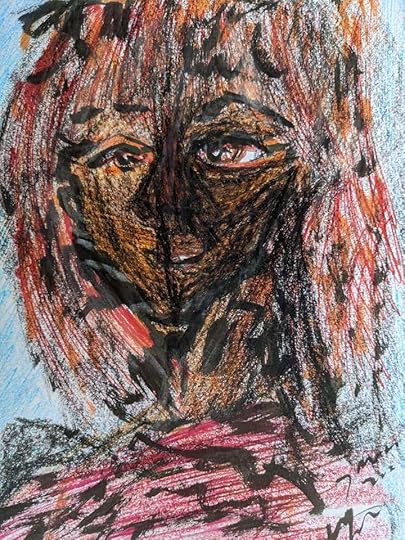
She is the balm of darkness after the agony of too much light. She is the peace of oblivion, free to rest without scrutiny for a while. The paths to her are many, and they are strewn with bones and broken dreams. There is no pain she does not understand. There is no horror that she cannot witness. She is the comfort when all comfort is gone. She is the last, desperate breath, and the breath that comes after it.
Come to her in despair. Come to her on your knees when you can no longer stand or walk. Bring her the broken wreck of your body and the ruined tatters of your mind.
Her temples are the cairns of stones on battlefields where no one remembers any more what the fighting was supposed to be about. Her temples are the mass graves of the nameless dead. Worship her when the night is pitch dark. Honour her when there is no way forward and yet somehow, you must continue. Whisper to her the names of those you know you will never see again. In her embrace, no one is lost or insignificant.
She does not offer redemption or forgiveness. Sit with her for long enough and you might find out how to make those things for yourself.
(Art by Dr Abbey)
March 29, 2021
White Violets
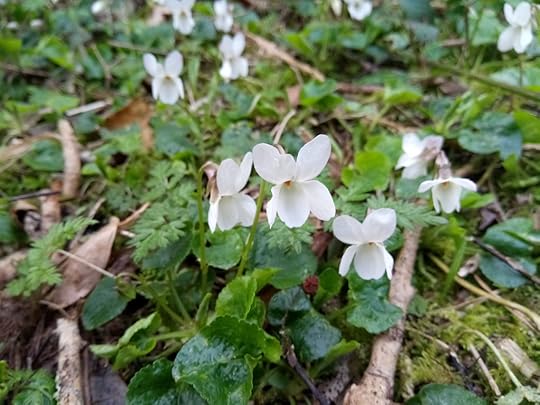
Wild violets are small spring flowers, and you will tend to find them in woodland and on banks and verges. They can be tucked in among other leaves and plants, so are quite easy to miss – especially the actually violet ones. White violets are a bit more self-announcing, their brightness makes them stand out amongst the greens. Later in the spring there will be other white flowers in the British woods – wild garlic and wood anemone.
One of the good things about focusing on plants when exploring the wheel of the year, is that they tend to stay still. You can admire them, and come back the next day with a camera, or a book to find out what they are. If you aren’t in the habit of spotting things, looking for wild flowers is a good place to start – simply scanning the edges of any path you are walking along will increase what you see.
It can take practice to spot birds, mammals and insects – but the more time you spend looking, the more you will see. The habit of a soft gaze, being gently attentive to what is around you will make wildflowers visible. It’s startling how oblivious we can be – I say this having taken urban pagans into the woods and supported them through the process of realising how much is actually there. When we’re caught up in our own concerns, we do not see the small beauties around us. Actively looking out for wild flowers is easy and rapidly rewarding and helps a person open themselves up to the natural world around them.
March 28, 2021
Stories we need to change
There are a lot of stories in popular culture that do far more harm than good. One of them goes as follows – and I’ve seen variations of it many times in films.
There are some men who have a job to do. A sexy lady person comes along and distracts them. The professional men suddenly become completely unable to do their job. They may be distracted enough that someone escapes, or plants a bomb, or otherwise thwarts what they were supposed to be doing. They may be so overwhelmed by the sexy lady person that they leave their post, hand over keys or otherwise actively mess up their job.
No one really benefits from this story. It tells men that they have no self control and will think with their balls at the slightest provocation. If there’s a sexy lady person in the room they may become unable to think or to act professionally. They may have no self control or integrity in face of a sexy lady person. This in turn supports narratives that when men experience desire they cannot be expected to control themselves or act responsibly, so it’s perpetuating rape culture.
Scenes like these tell women that sexuality is how women get things done. Sexy clothing, provocative behaviour and offering sex will allow you to manipulate men. Power for women thus becomes entangled with being young – because we don’t tend to present older women as sexually appealing. The accident of beauty is the only possible source of power and worth. Most women therefore will not have an option on being powerful on these terms. It tells women they should be glad when men focus on them sexually because this is the only kind of power they can have. Also sexy women tend to be ‘bad guys’. This is all very patriarchal.
There are stories in which the roles are reversed, but what tends to happen is that the women fall in love with the men, and may switch sides on the basis of this. The women are more likely to be persuaded by the righteous cause the man has, as well as his handsome face. Men are invariably able to use power in other ways alongside persuading key women to act on their behalf. Men using their sexy powers are more likely to be heroes than villains.
A single instance of a story like this doesn’t do much harm, but it’s such a frequently used plot device – and it is lazy as a plot device as well. We see it too often, we hear its messages too often. It’s a crappy story that may do more to shape how people think of themselves than it does to reflect how people really are.
March 27, 2021
What if we worked less?
The idea of four day working weeks is something many people have considered, and some businesses have even tried. How different would our lives be if we could afford to only work four days a week? What would change for us? How would we be impacted by other people working less?
Larger businesses can undoubtedly afford to pay workers the same money for four day weeks, and take on more workers to fill the gap. This would improve employment rates. In any sizeable business, there are management people and shareholders making a profit out of the work being done. A bit less money for them and a bit more investment in the people doing the work would make this possible. What evidence there is from people trying four day weeks is that you get a more motivated, healthier and more productive workforce, so it’s not really much of a sacrifice for the would-be profit makers.
I’m self employed so there’s no company that could treat me better than it does. But, if more people had more time off, I would benefit. More books would be read and more people would have energy to invest in leisure, which would probably improve my situation in turn.
More time off means having the scope to do more than just rest, recover and sort out your domestic stuff. More time off means more opportunity to enrich your life. What would you do with that extra day? You might study, or volunteer. You might invest more time in your physical health, or develop hobbies and skills that enrich your life. You’d have more time to meditate, contemplate, get outside, maybe grow your own food. Perhaps some of the less sustainable things you have to do out of time poverty could be changed.
How much of your life is currently organised around being time poor and tired from work? How much time do you even get to think about how you are living day to day? What would change if the people around you had more spare time? What would become available, emotionally and socially that isn’t possible at the moment? Who would you spend more time with?
What would it do to the economy if there was far more employment available, and people also had far more time to enjoy themselves? How would our spending choices change? What would happen to our towns, our communal spaces, and our green spaces if we had more time to use and appreciate them?
Poverty is stressful. Open up more working options, and many people would be in a far better state psychologically. Overwork has long been identified as a source of mental health problems. Stress and exhaustion make us sick, and exacerbate any illnesses we have. How much more well would we all be with a four day working week?
How would education change if a four day week was normal? How much more flexible could we make it, how many more options might people of all ages have around opportunities to learn and develop?
Asking what if we worked less also means considering some fundamental questions about what our lives are for and who they should benefit. Having more time for ourselves would make our lives much more about our own happiness and wellbeing, and that would be a truly radical shift.
March 26, 2021
Writing about nature
When I first initiated as a bard, I pledged to use my creativity for the good of the land and for the good of my tribe. (Use of the word ‘tribe’ by white western Pagans is problematic to say the least, but that was the pledge nearly 20 years ago). The principle of making your art as an act of service is a good one, but how does that translate into action?
Writing about nature can be a way of engaging people with the natural world and inspiring them to notice it more and care about it more. If you’ve grown up urban, and never been taught the names of trees or butterflies or wild plants, then it can all be a bit of a mystery, and not in a good way. There’s quite a journey from seeing trees to seeing specific, individual trees with unique characteristics. Equally, it’s quite a journey from seeing some birds, to knowing a bit about those birds and how they live.
One of the things I try to do with poetry is to talk about nature specifically. Bandying the word ‘nature’ about doesn’t get much done – as this blog post already illustrates. It’s not a word that creates engagement. What seems to work best, is precision. A specific tree, an actual encounter, something personal, something experienced.
It can be tempting to make nature into a metaphor for personal experience, but that doesn’t do much to help the land. It fuels the idea of nature as a resource for humans to use if we deploy it in poetry as a way of talking about ourselves all the time. Equally, if the landscape is just a background framing human actors, it is still mostly scenery and mostly something we consume.
If you’d like any of my poetry, there are pdfs (pay what you like) on my ko-fi store – https://ko-fi.com/O4O3AI4T/shop
I was also a finalist in a recent competition to write poetry about urban trees – you can read that here – https://www.treesforcities.org/stories/our-poetree-winners
March 25, 2021
Community and Crime
I’m working on a book about darkness (You can get regular instalments of my progress over on Patreon – https://www.patreon.com/NimueB ). The relationship between darkness and crime, light and crime prevention is something I’ve been looking at. I recently came across a study that suggested some really interesting things. Apparently lighting tends to reduce crime in areas, but that the crime reduction applies to the day as well as the night, so the impact of light improvement isn’t actually about visibility, necessary.
This got me thinking about other studies I’ve seen about the way tree planting impacts on crime. I’ve blogged about this before. Put in trees and crime reduces. We’re less violent when we have trees. It strikes me that these things may well be related. In both cases what might be happening is a feeling that a space is valued, and by extension, the people in the space are valued. Investment in community infrastructure could well have an impact on peoples’ sense of self worth.
Quite a lot of crime is opportunistic and not especially planned. What kinds of feelings do you have to have about a place and its people to go in for opportunistic crime? If you felt more engaged, more involved, more like part of a community, would that work the same way? Regeneration projects tend to increase feelings of involvement and engagement, especially when people are involved and not just having it done to them.
What happens when we see ourselves as connected? What happens when we’re given opportunities for cooperation and have shared spaces we can use communally? Perhaps how people treat spaces and each other isn’t intrinsic to said people, and has more to do with how the space impacts on them. We are influenced by our environments, and the spaces we spend time are full of messages about who we are and what we can expect. Most of those messages are absorbed unconsciously. If your environment gives you constant messages of isolation and worthlessness, what are the odds of you feeling warm, positive and generous towards your surroundings and fellows?
Planting trees. Having well considered street lighting. How we shape our shared spaces may be key to the kinds of relationships we have with each other.
March 24, 2021
Adventures in patchwork
I really like unique clothing. I also hate waste, and these two things often result in me making patchwork clothes out of otherwise dead items.
When jeans wear out, it tends to be at the ankle, the knee and the front of the thigh. This leaves a lot of fabric still in good condition in the calves and backs of thighs. So, when a pair of jeans die, I take them and I salvage the usable bits.
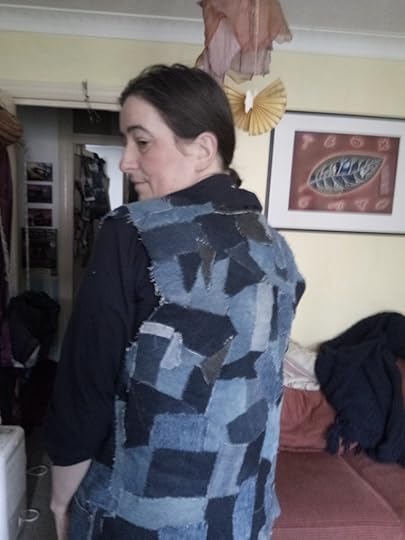
In this waistcoat project I’ve been using the small scraps left over from making a jacket for Tom. I used an old waistcoat as a pattern, and a lot of pins to get the small pieces into shape. The sewing is rough – it just needs to hold the denim together. I am now in the process of embroidering the whole thing – the embroidery will do most of the structural work and makes the garment solid and durable.
The resulting garment will be unique. It doesn’t matter how many waistcoats I make, no two will ever be the same. That cheers me. There’s something so very sad and drab about one size fits no one supermarket clothing, and so many people are stuck wearing that for lack of anything better that’s also affordable.
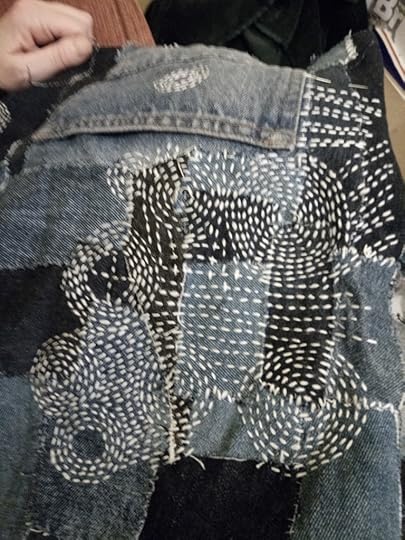
Throw away fashion is incredibly harming to the planet. Anything we can do to slow down our consumption of clothing is a good idea. For me, this kind of repurposing is a way of doing that while also having clothing that is original, and interesting. I find joy in making things, and in remaking. There’s a pleasure in keeping clothing out of landfill and in getting to use skills I have developed. Nothing in this waistcoat is especially difficult to do nor did it require much specialist kit – pins, scissors, sewing thread and needles, fine wool and an embroidery needle. Mostly it calls for patience. It’s an affordable hobby alongside being useful and eco-friendly.
This is all based on boro patchwork and sashiko sewing.
March 23, 2021
The Goddess of Hellfire
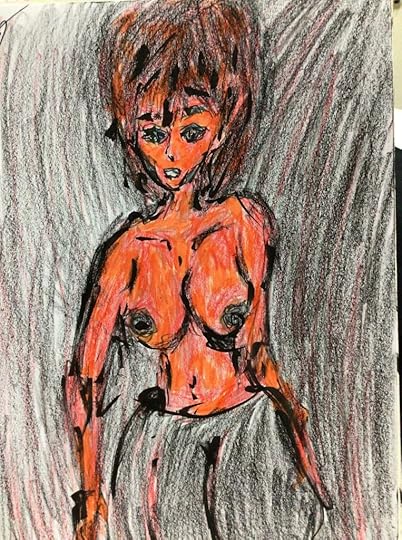
She has many names. Those who do not love her call her the Goddess of Hellfire for they can only see the destruction she causes.
She is the Goddess of the cleansing flame that cauterizes wounds and wipes away the unbearable past.
She is the fire into which you can make sacrifice, and in making sacrifice you may find peace, and freedom and transformation.
She is the fire raging through ruins. The fire that war starts but cannot control. She is the end of your schemes, the end of your hubris and your illusions of power.
She has no temples, you can only worship her where there are living flames.
(Art and concept by Dr Abbey – this is part of an ongoing project we’re doing together. I’m considering a setting for a work of fiction that has a lot of Goddesses in it, but I won’t be drawing on existing pantheons to do this. It’s going to be an interesting process finding out who the Goddesses are in this setting, and what their followers do, and where they meet. One of the other intentions is to challenge how bodies are read, so there will be bare breasted priestesses and naked angels who are naked because they are innocent. I feel very strongly that a person’s sexual identity should not be read from their bodies, this is something we’ve been talking about as we’re exploring with the world building.)



